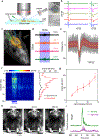Rational design of silicon structures for optically controlled multiscale biointerfaces
- PMID: 30906646
- PMCID: PMC6430241
- DOI: 10.1038/s41551-018-0230-1
Rational design of silicon structures for optically controlled multiscale biointerfaces
Abstract
Silicon-based materials have been widely used. However, remotely controlled and interconnect-free silicon configurations have been rarely explored, because of limited fundamental understanding of the complex physicochemical processes that occur at interfaces between silicon and biological materials. Here, we describe rational design principles, guided by biology, for establishing intracellular, intercellular and extracellular silicon-based interfaces, where the silicon and the biological targets have matched properties. We focused on light-induced processes at these interfaces, and developed a set of matrices to quantify and differentiate the capacitive, Faradaic and thermal outputs from about 30 different silicon materials in saline. We show that these interfaces are useful for the light-controlled non-genetic modulation of intracellular calcium dynamics, of cytoskeletal structures and transport, of cellular excitability, of neurotransmitter release from brain slices, and of brain activity in vivo.
Conflict of interest statement
Code availability Custom codes used to analyze the data are available upon reasonable request to the corresponding author. Competing financial interest The authors declare no competing financial interests.
Figures




Comment in
-
Silicon biointerfaces for all scales.Nat Biomed Eng. 2018 Jul;2(7):471-472. doi: 10.1038/s41551-018-0268-0. Nat Biomed Eng. 2018. PMID: 30948826 No abstract available.
References
-
- Viventi J, Kim DH, Vigeland L, Frechette ES, Blanco JA, Kim YS, Avrin AE, Tiruvadi VR, Hwang SW, Vanleer AC, Wulsin DF, Davis K, Gelber CE, Palmer L, Van der Spiegel J, Wu J, Xiao J, Huang Y, Contreras D, Rogers JA & Litt B Flexible, foldable, actively multiplexed, high-density electrode array for mapping brain activity in vivo. Nature Neuroscience 14, 1599–1605, 10.1038/nn.2973 (2011). - DOI - PMC - PubMed
Grants and funding
LinkOut - more resources
Full Text Sources
Other Literature Sources

